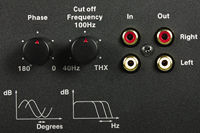Jamo D 7PEX Speaker System Page 2
The manual that comes with these speakers is truly an international affair, using wordless diagrams peppered with little smiley faces to indicate good things and sad faces to indicate bad things. By avoiding text altogether, it conveys only the most basic information. With a system as involved and dependent on careful installation as this one is, we really need more direction, although I suspect that Jamo feels that, with a system this expensive, the retailer should handle the installation. At least the legal department managed to get its way, as the warranty and safety information is printed in 23 languages.
 In my room, the front speakers need to sit out from the wall, so this is how I used the D 7LCRs for the main left, right, and center channels. First, I tried them in the free-space setting, with the second set of binding posts connected, but I found that this setup made the sound a bit too thick and closed-in. When I removed the jumpers, the sound opened up and had an added sense of liveliness. In accordance with the THX requirements, these speakers are quite directional. I was careful to adjust each speaker's tilt and height, making sure that the baffle was perpendicular with my ears. Once I had the LCRs' sound dialed in, I adjusted the subwoofers' phase and set the levels for all five channels. My B&K Reference 30 pre/pro allowed me to control each channel's distance and levels independently, which really helped. On the crossover, I used the standard 80-Hz THX setting for all channels.
In my room, the front speakers need to sit out from the wall, so this is how I used the D 7LCRs for the main left, right, and center channels. First, I tried them in the free-space setting, with the second set of binding posts connected, but I found that this setup made the sound a bit too thick and closed-in. When I removed the jumpers, the sound opened up and had an added sense of liveliness. In accordance with the THX requirements, these speakers are quite directional. I was careful to adjust each speaker's tilt and height, making sure that the baffle was perpendicular with my ears. Once I had the LCRs' sound dialed in, I adjusted the subwoofers' phase and set the levels for all five channels. My B&K Reference 30 pre/pro allowed me to control each channel's distance and levels independently, which really helped. On the crossover, I used the standard 80-Hz THX setting for all channels.
Even with the jumpers removed, the overall sound was a little bit on the warm side; yet, at the same time, it always remained very clear and quite transparent. Tonally, it's quite different from, say, the Monitor Audio Silver Series system I reviewed in November 2002, which had a very punchy, dynamic, in-your-face sound. The Jamo system could knock you over with its power and dynamics, yet the blow tends to be a bit more like Lennox Lewis' boxing glove than Tony Soprano's brass knuckles.
Dipole surround speakers re-create the soundfield very differently than direct-radiating speakers, giving you a wash of surround information rather than direct pinpoint cues. When I added the direct-radiating rear surround speakers, however, I found that the sound of the overall package gained a new anchor, making front-to-rear pans and flyovers incredibly dimensional. Even though the D 7PEX ensemble is unashamedly geared toward home theater use, it does a fine job with music. The CD layer of Chesky's 4 Generations of Miles SACD sounded wonderful, with spot-on tonal contrasts and amazing depth for a simple two-channel recording.
Jamo also seems to have designed the D 7SUB with home theater sound in mind, as its greatest strength is its uncanny ability to deliver hard-hitting midbass impact rather than the super-low-frequency air-wafting bass that some music requires. Despite having to handle the bass from all seven speakers and the LFE channel, the D 7SUB always integrated very well into the overall sound, never drawing undue attention to itself.
So, from a bunch of Danes, we get a system that perfectly fits the Danish stereotype. Without shouting, "Hey, listen to me," the D 7PEX ensemble does a terrific job of re-creating the movie theater experience in your home. It can play amazingly loudly and deliver knockout dynamics without flinching, yet it never becomes aggressive or tiring to listen to. Add packaging that even a decorator could love, and it looks like the Danish are poised to creep even further into our psyche.
HIGHLIGHTS
• THX Ultra 2-certified
• Plays loudly with excellent dynamics and no congestion
• Low-profile wall-mounted design stays out of the way

- Log in or register to post comments






























































